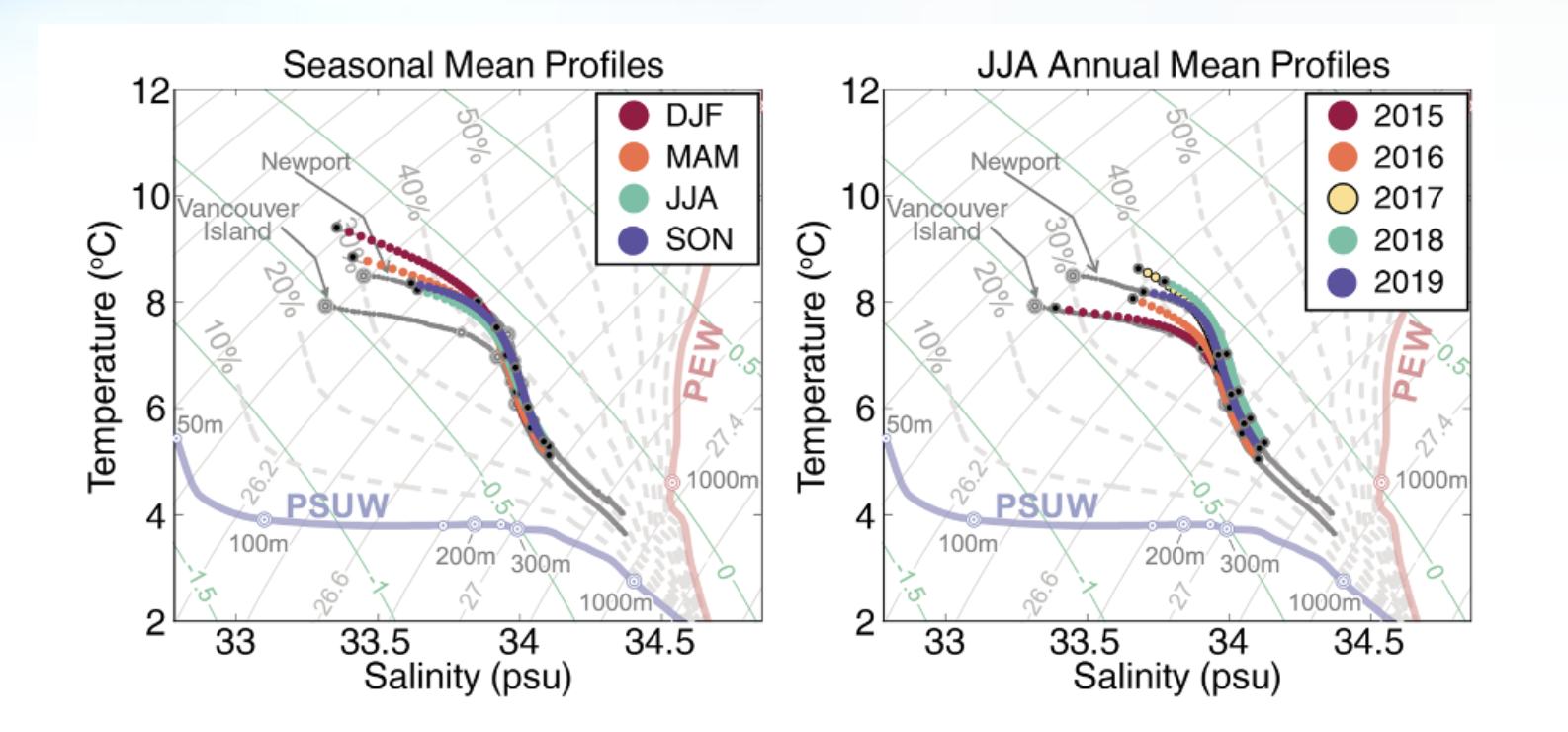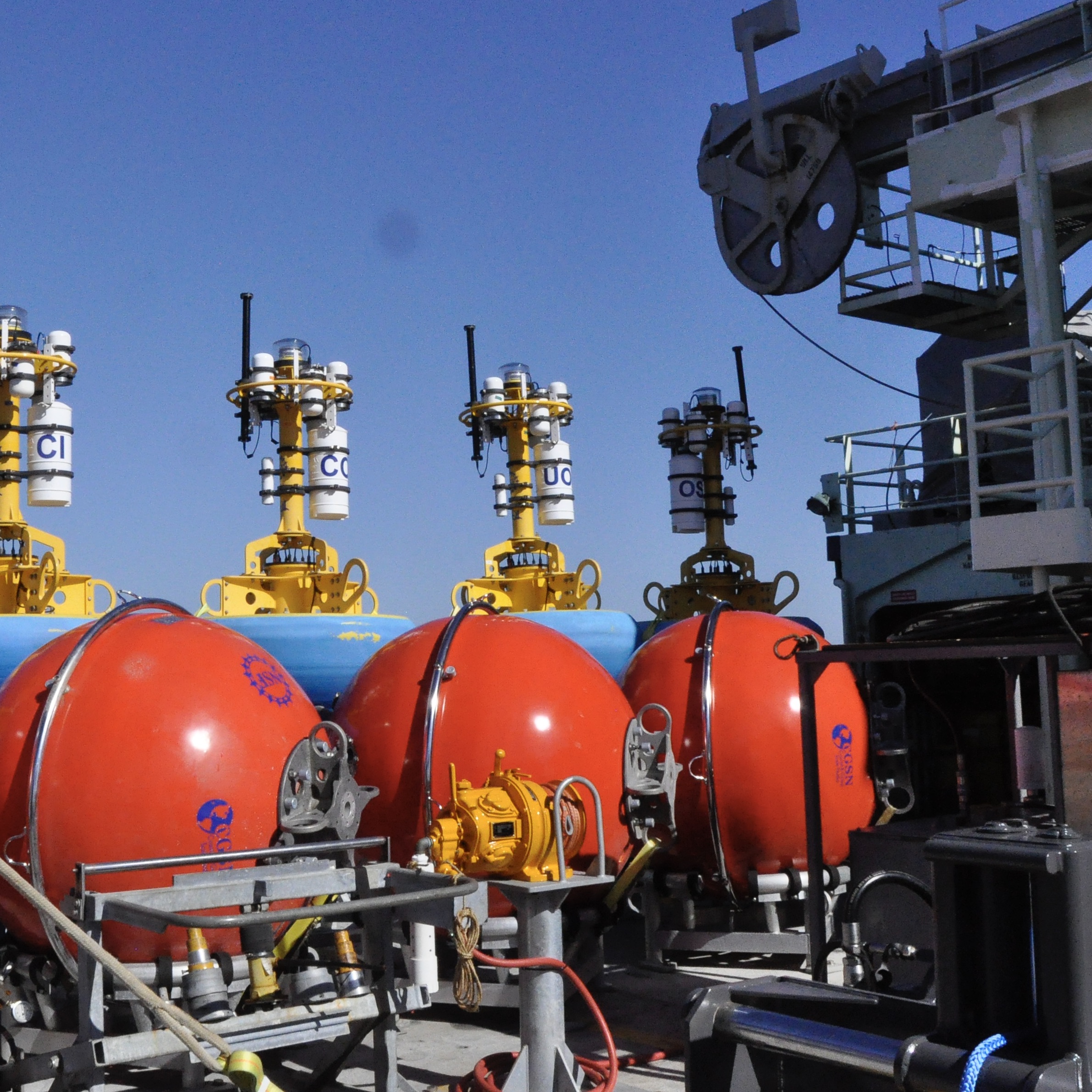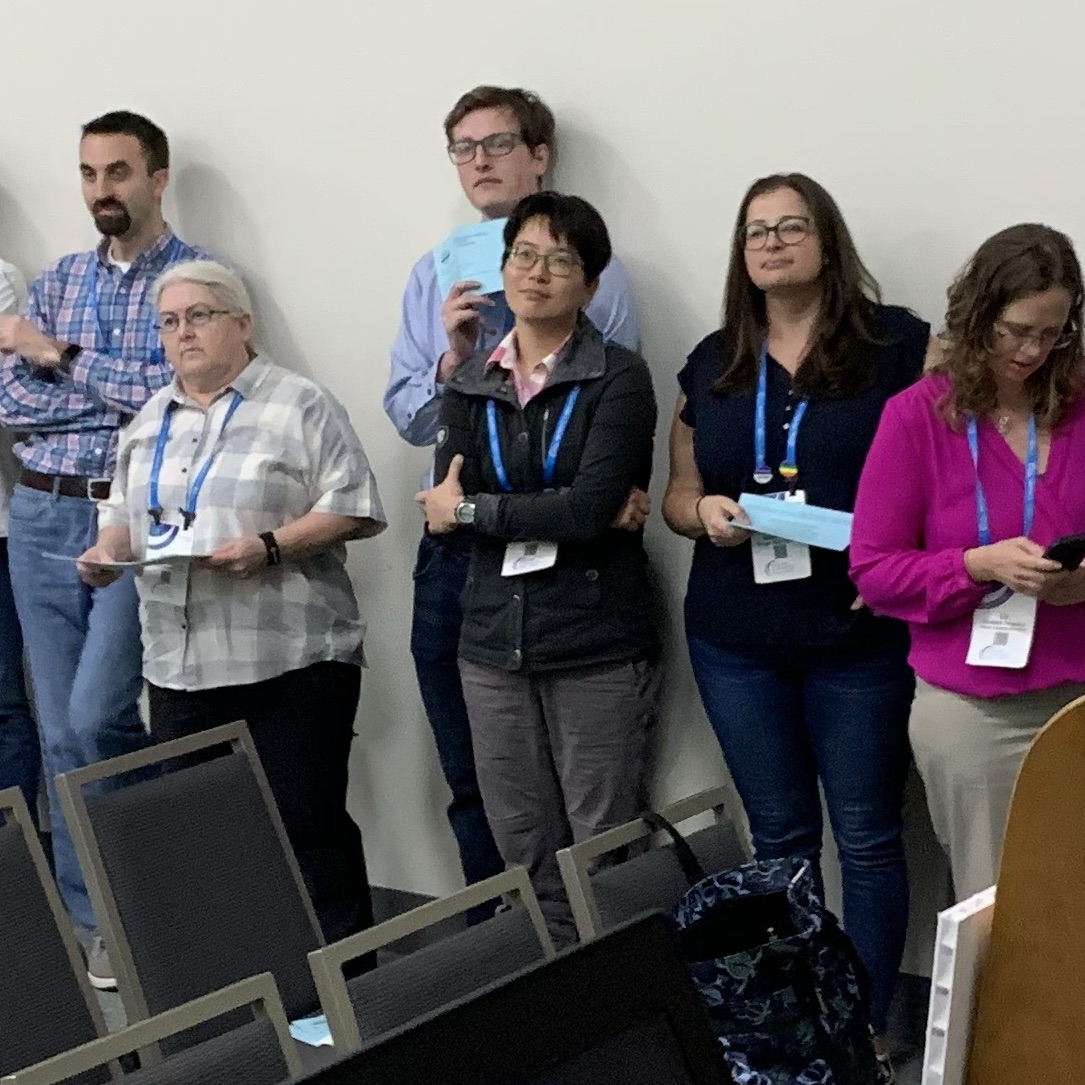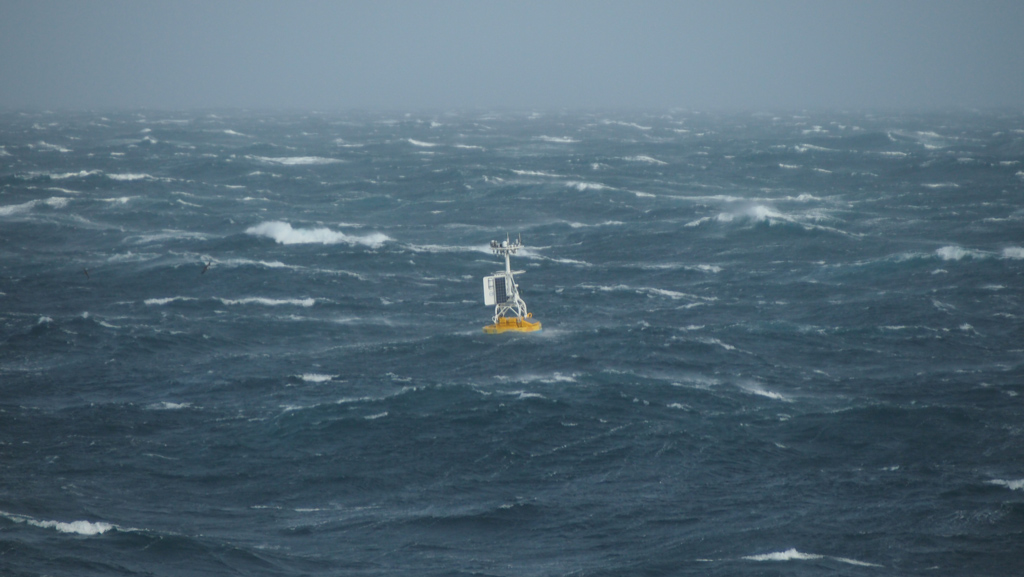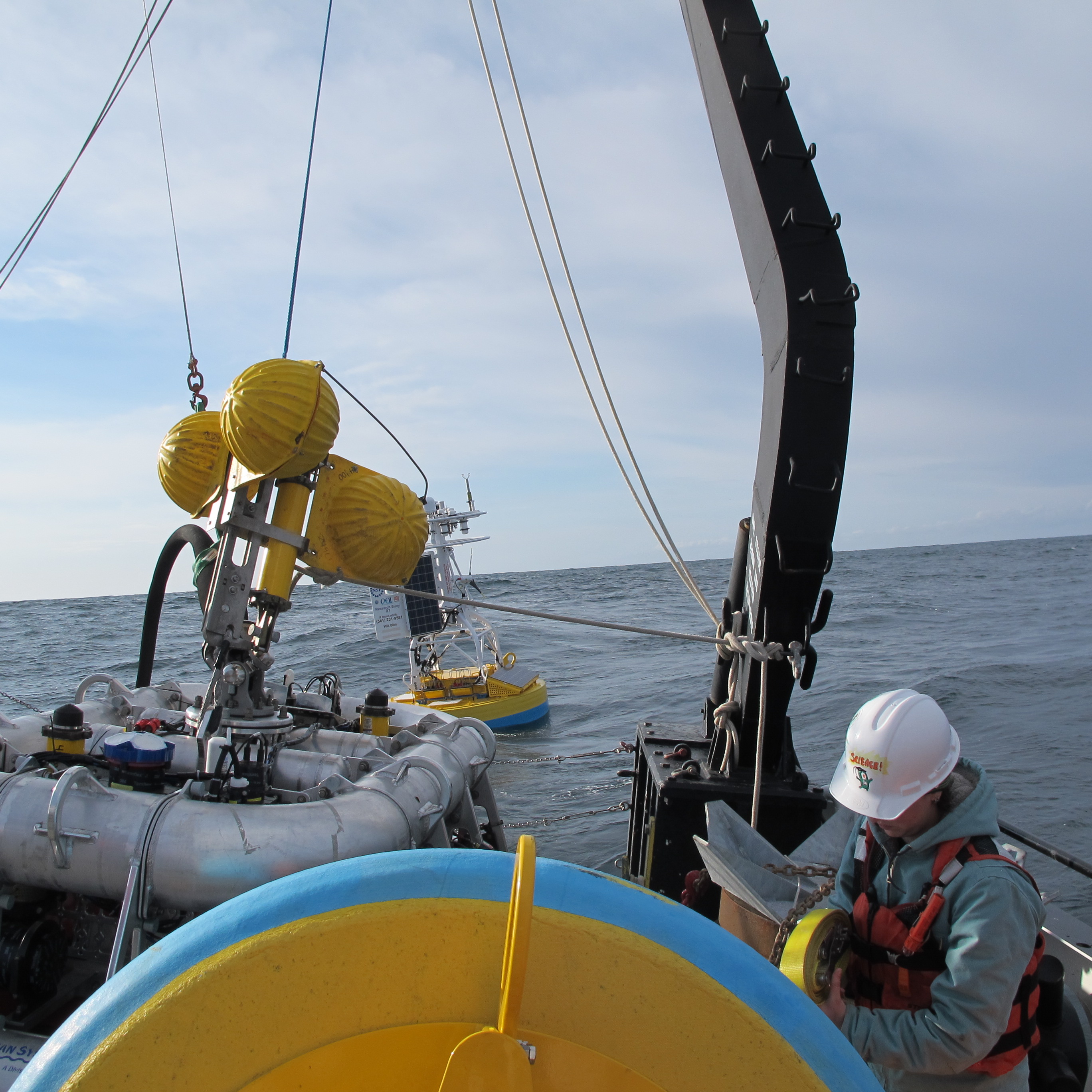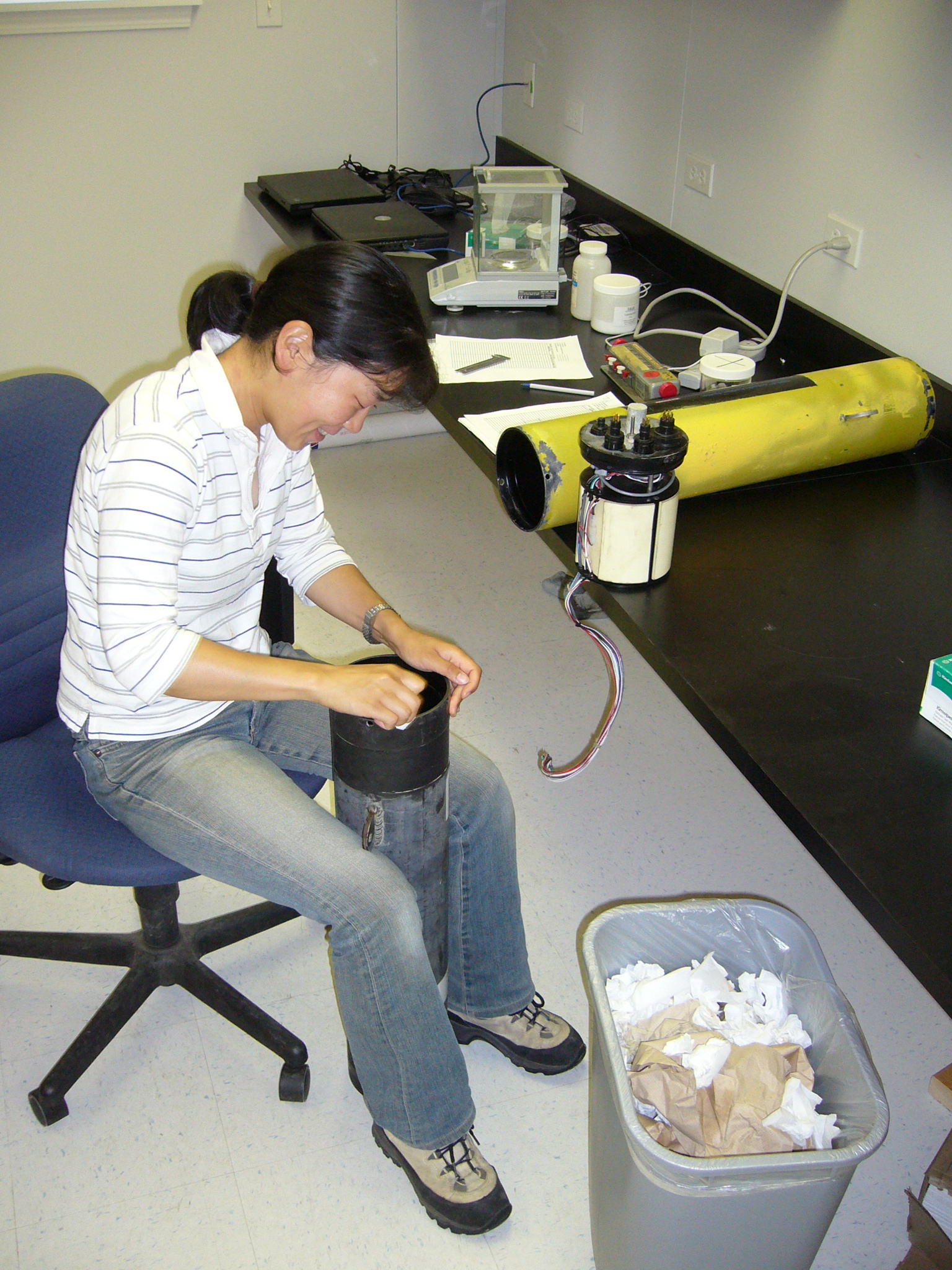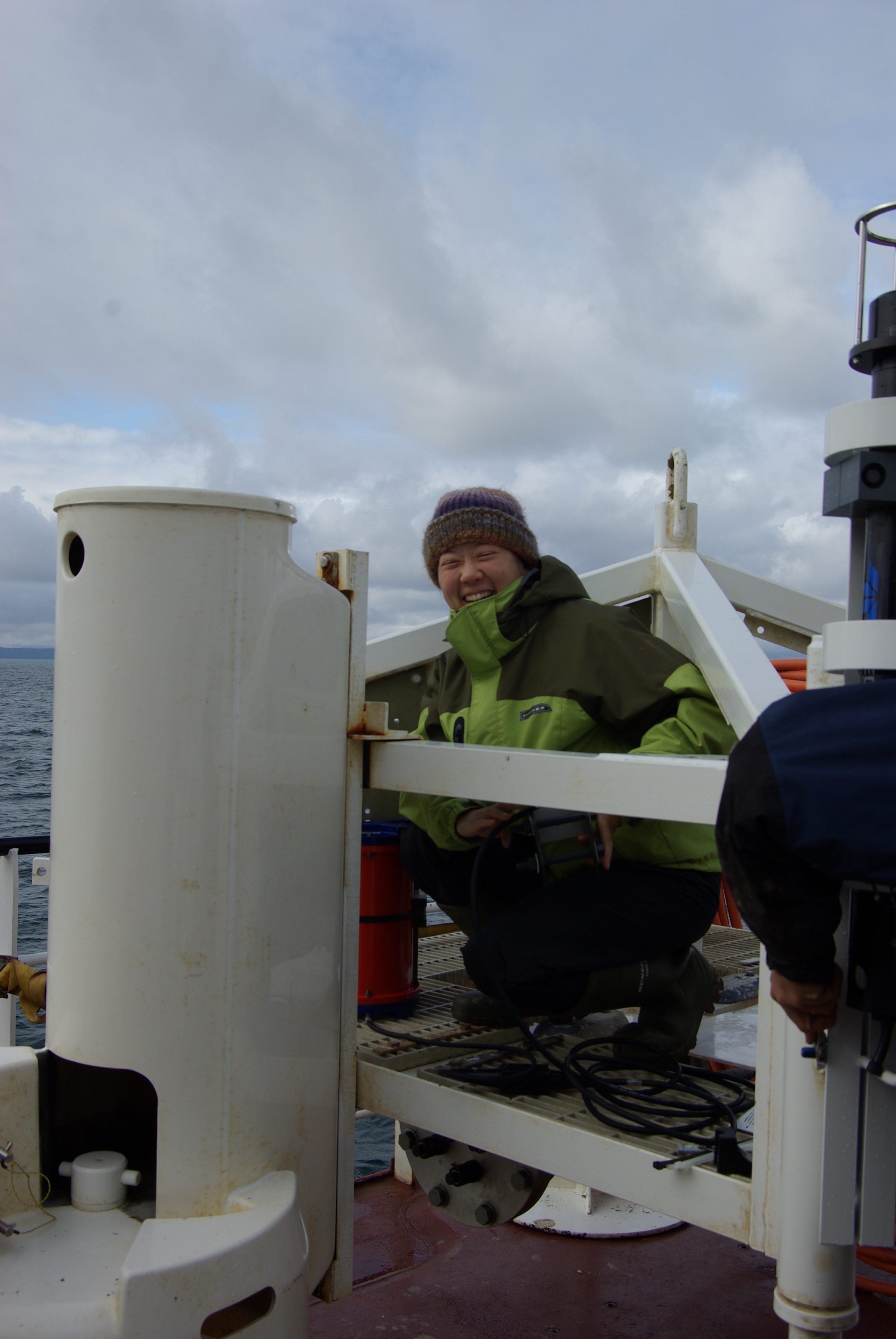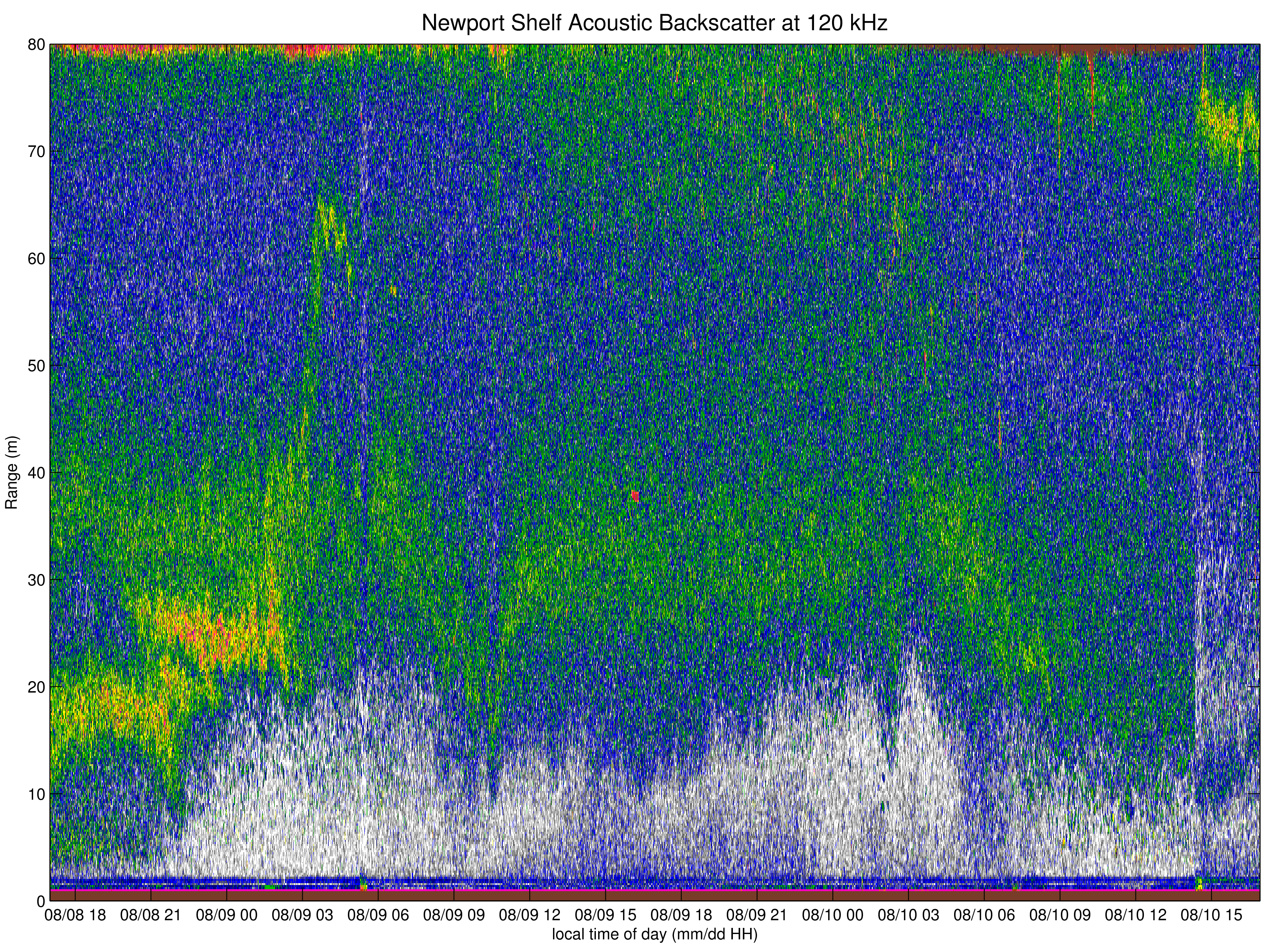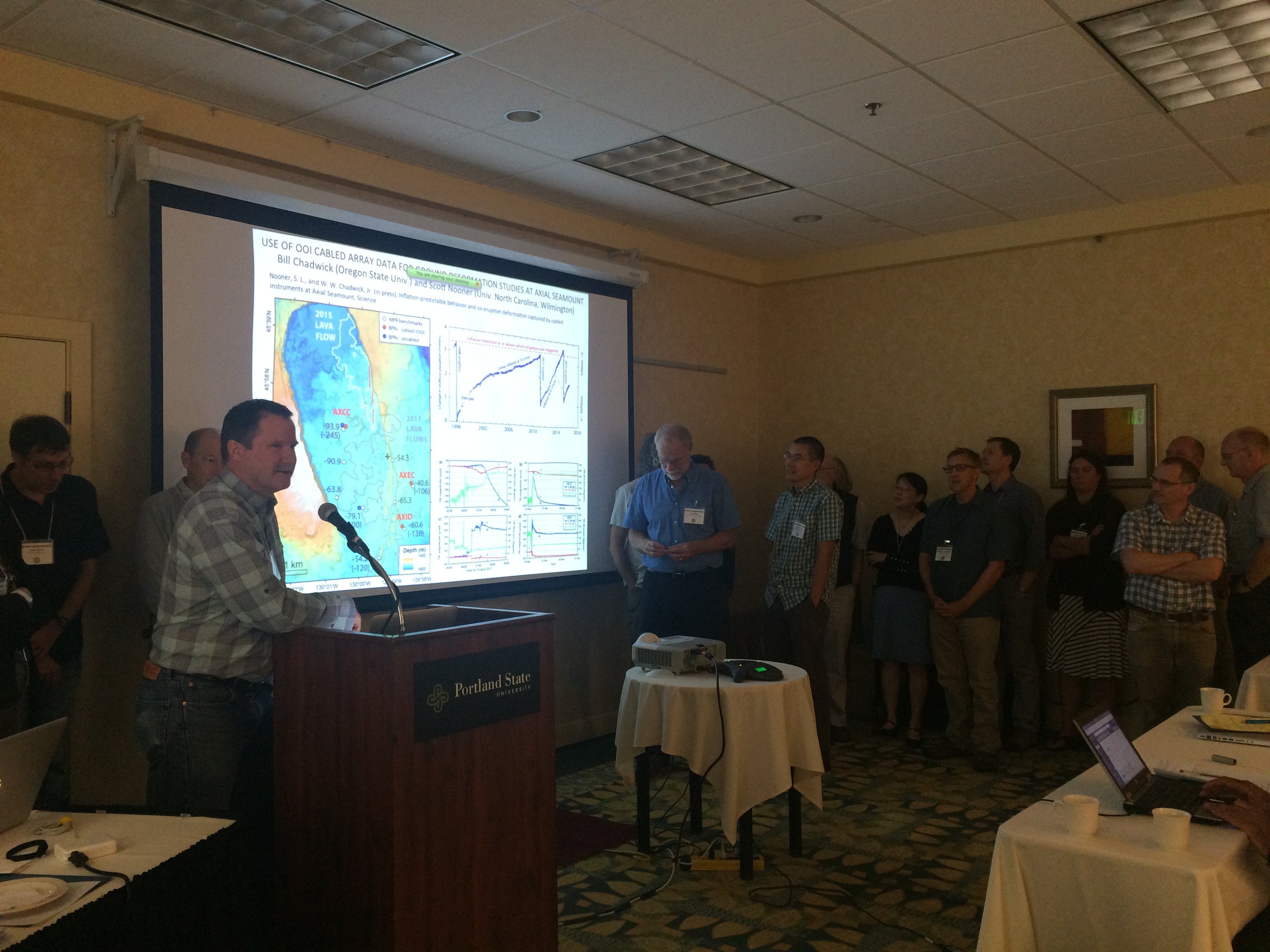Posts Tagged ‘Endurance Array’
Delineating Biochemical Processes in the Northern California Upwelling System
Excerpted from the OOI Quarterly Report, 2022.
[media-caption path="/wp-content/uploads/2020/10/Endurance-Array-Science-Highlight.png" link="#"]Figure 19: Regional T/S variability at the Washington offshore profiling mooring. The end member Pacific Subarctic Upper Water (PSUW) and Pacific Equatorial Water (PEW) masses are indicated on each plot at the left and right respectively. T/S at the mooring is a mixture of PSUW and PEW. The left plot shows the seasonal variability. The right plot shows interannual variability in summer. Interannual variability from 100-250m exceeds seasonal variability. In 2015, T/S at the mooring is closer in character to climatological averages at Vancouver Island, BC while in 2018, T/S at the mooring is similar to that south of Newport, OR. Figure from Risien et al. adapted from Thomson and Krassovski (2010).[/media-caption]
Risien et al. (2020) presented over five years of observations from the OOI Washington offshore profiling mooring. First deployed in 2014, the Washington offshore profiler mooring is on the continental slope about 65 km west of Westport, WA. Its wire Following Profiler samples the water column from 30 m depth down to 500 m, ascending and descending three to four times per day. Traveling at approximately 25 cm/s, the profiler carries physical (temperature, salinity, pressure, and velocity) and biochemical (photosynthetically active radiation, chlorophyll, colored dissolved organic matter fluorescence, optical backscatter, and dissolved oxygen) sensors. The data presented included more than 12,000 profiles. These data were processed using a newly developed Matlab toolbox.
The observations resolve biochemical processes such as carbon export and dissolved oxygen variability in the deep source waters of the Northern California Upwelling System. Within the Northern California Current System, over the slope there is a large-scale north-south variation in temperature and salinity (T/S). Regional T/S variability can be understood as a mixing between warmer, more saline Pacific Equatorial Water (PEW) to the south, and fresher, colder Pacific Subarctic Upper Water (PSUW) to the north. Preliminary results show significant interannual variability of T/S water properties between 100-250 meters. In summer, interannual T/S variability is larger than the mean seasonal cycle (see Fig 19). While summer T/S variability is greatest on the interannual scale, T/S does covary on a seasonal scale with dissolved Oxygen (DO), spiciness and Particulate Organic Carbon (POC). In particular, warmer, more saline water is associated with lower DO in fall and winter.
Risien, C.M., R.A. Desiderio, L.W. Juranek, and J.P. Fram (2020), Sustained, High-Resolution Profiler Observations from the Washington Continental Slope , Abstract [IS43A-05] presented at Ocean Sciences Meeting 2020, San Diego, CA, 17-21 Feb.
Thomson, R. E., and Krassovski, M. V. (2010), Poleward reach of the California Undercurrent extension, J. Geophys. Res., 115, C09027, doi:10.1029/2010JC006280.
Read More
UNOLS Extends Guidance to Suspend Cruises through 1 July 2020
The University-National Oceanographic Laboratory System (UNOLS), which coordinates oceanographic ships’ schedules, recommended on 17 March 2020 that cruise activities be paused for 30 days due to the COVID-19 pandemic. On 30 March UNOLS extended its guidance to suspend research cruises to July 1 2020. This action is designed to protect the health and safety of the crews and scientific parties.
The planned spring operation and maintenance (O&M) cruise to the Endurance Array in March was affected by the original 30-day guidance. The upcoming O&M cruises for the Pioneer, Irminger, and Papa Arrays aboard R/V Neil Armstrong and R/V Sikuliaq are impacted by this latest guidance.
The OOI is working with UNOLS and ship operators to find potential opportunities to complete the scheduled cruises and conduct needed maintenance on the arrays. In the meantime, there’s been no interruption in OOI data. OOI data continue to be collected and made available for use by the scientific and educational communities.
Read MoreFifteen Findings in 15 minutes
“Just like lightning,” in one-minute presentations, 15 scientists shared amazing ways they are using OOI data in scientific investigations and in the classroom. This round of lightning talks capped the Ocean Observatories Initiative Facility Board’s (OOIFB) Town Hall at the 2020 Ocean Sciences Meeting on 20 February, demonstrating the multiple and creative ways OOI data are being used to answer key science questions in a changing environment.
The presentations ranged from how students are using real-life and real-time OOI data to advance their understanding of scientific principles to how researchers are using OOI data to identify the presence of marine life by sound to how modelers are making OOI data more accessible and useable.
“We were simply thrilled by the depth, breadth, and range of applications of OOI data shown during this lightning round,” Kendra Daly, chair of the OOIFB. “We were pleased so many presenters were willing to accept the challenge. This enthusiastic response clearly shows that OOI data are being used to help answer important science questions.”
Brief summaries of the talks are presented below.
Advancing science
Isabela Le Bras, Scripps Institution of Oceanography, reported on a recent article in Geophysical Research Letters, where she and her colleagues describe how they used data from the Irminger Sea Array moorings (2014–2016) to identify two water masses formed by convection and showing that they have different rates of export in the western boundary current. Upper Irminger Sea Intermediate Water appears to form near the boundary current and is exported rapidly within three months of its formation. Deep Irminger Sea Intermediate Water forms in the basin interior and is exported on longer time scales. The subduction of these waters into the boundary current is consistent with an eddy transport mechanism. The eddy transport process is more effective for the waters cooled near the boundary current, implying that cooling near boundary currents may be more important for the climate than has been appreciated to date.
Since 2017, Clare Reimers and Kristen Fogaren, Oregon State University, have been working to assess seasonal variability in benthic oxygen consumption and the contribution of benthic respiration to the development of hypoxic conditions in the northern California Current, using time series data from the OOI Endurance Array. Reimers and Fogaren measured benthic oxygen consumption rates using in situ eddy covariation techniques and ex situ core incubations, during a series of ten cruises that allowed sampling near the Endurance Oregon Shelf and Inshore stations, in all seasons. During these cruises, the researchers used real-time data provided by the Endurance Array to optimize the settings for their eddy covariance deployments. They are now examining property-relationships in discrete bottom water samples collected during the cruises and using data from OOI assets to help separate influences of mixing and biochemical processes in the water column and sediments. The researchers are also synthesizing benthic flux measurements and placing these rates in the context of cross-shelf glider measurements and benthic node time series.
Adrienne Silver, University of Massachusetts Dartmouth provided details about how she is using Pioneer Array data to learn more about the influence of warm core rings on Shelf break circulation. Results from a 40-year Warm Core Ring census show a regime shift in warm core ring formation at 2000, with the number of rings doubling from an average of 18 rings per year (during 1980-1999) to 33 rings per year (during 2000-2019). This regime shift creates a large increase in the amount of warm salty water being transported northward toward the shelf from the Gulf Stream. The preferred pathway of these rings, or the Ring Corridor seem to indicate their proximity to the shelf break and the Pioneer array during their lifetime. The goal of Silver’s project is to understand how these warm core rings affect the shelf break exchange while traveling along the shelf. A large focus of the study will be on the salinity intrusion events which might be sourced from these warm core rings.
Liz Ferguson, CEO and founder of Ocean Science Analytics, is using data from OOI’s Coastal Endurance and Regional Cabled Arrays to determine the variables that are most useful for assessing the ecosystem of this region and obtaining baseline information on marine mammal acoustic presence for use in monitoring. Using long term physical and biological data provided by these arrays, Ferguson is assessing long-standing shifts in the ecology of this coastal and offshore environment by associating physical oceanographic variables with the vocal presence of marine mammals using the broadband hydrophone data. Temporal changes in the occurrence of marine mammal species such as killer whales, sperm whales and dolphins can be used as an indicator of ecosystem shifts over time. She is analyzing passive acoustic data provided by the OOI arrays to determine the presence of vocally active marine mammal species, identify their spatial and temporal use of these sites, and combining this information with the physical oceanographic variables to assess the ecological characteristics associated with marine mammal occurrence.
Sam Urmy of the Monterey Bay Aquarium Research Institute (MBARI) also is using OOI acoustical data in his research. Using an upward-looking echosounder and a high-frequency hydrophone at MBARI’s Monterey Accelerated Research System, Urmy showed how small animals in the epipelagic and mesopelagic altered their behavior in response to predators. These responses included abrupt dives during bouts of foraging by dolphins, changes in depth to avoid predatory fish schools, and dramatic alterations to daily vertical migratory behavior. Continual observations of the mesopelagic with active and passive acoustics are revealing several dynamic predator-prey interactions in an ecosystem that is typically thought of as relatively slow and static.
Veronica Tamsitt of the University of New South Wales used the OOI’s Southern Ocean mooring and the Southern Ocean Flux Site (SOFS, in the Southeast Indian) to study the Sub Antarctic Mode water (SAMW) formation. Tamsitt’s and her colleagues findings were reported in the Journal of Climate in March 2020. Using data from the two mooring locations, the researchers were able to compare and contrast characteristics and variability of air-sea heat fluxes, mixed-layer depths, and SAMW formation. The researchers found that inter mixed-layer depth anomalies tended to be intermittent at the two moorings, where anomalously deep mixed layers were associated with anomalous advection of cold air from the south, and conversely shallow mixed layers correspond to warm air from the north. Both the winter heat flux and mixed-layer depth anomalies, however, showed a complex spatial pattern, with both positive and negative anomalies in both the Indian and Pacific basins that Tasmitt and colleagues relate to the leading modes of climate variability in the Southern Ocean.
Editor’s note: The Southern Ocean Array was decommissioned in January 2020. Its data, however, are still available for use by researchers, students, and the public.
Bringing OOI data into the classroom
Sage Lichtenwalner, Department of Marine and Coastal Sciences at Rutgers, The State University of New Jersey reported on the progress of the Ocean Data Labs Project. This project is a Rutgers-led effort to build a “Community of Practice” to tap into the firehose of OOI ocean data to support undergraduate education. To date, the project has hosted four “development” workshops that introduced participants to the OOI, conducted data processing with Python notebooks, and shared effective teaching strategies, in addition to a series of introductory workshops and webinars. As part of the development workshops, 56 university, college, and community college faculty designed 19 new “Data Explorations,” featuring web-based interactive “widgets” that allow students to interact with pre-selected data from the OOI. The project also sponsors a series of webinars, a fellowship program, and is compiling a library of resources (including coding notebooks, datasets, and case studies in teaching) to help the community.
Cheryl Greengrove, University of Washington Tacoma, summarized an article in the March issue of Oceanography that she and colleagues from across the United States wrote detailing ways to integrate OOI data into the undergraduate curriculum. The wealth of freely-accessible data provided by OOI platforms, many of which can be viewed in real or near-real time, provides an opportunity to bring these authentic data into undergraduate classrooms. The TOS article highlights existing educational resources derived from OOI data that are ready for other educators to incorporate into their own classrooms, as well as presents opportunities for new resources to be developed by the community. Examples of undergraduate introductory oceanography OOI data-based lessons using existing interactive online data widgets with curated OOI data on primary productivity, salinity, and tectonics and seamounts are presented, as well as ways to use OOI data to engage students in undergraduate research. The authors provide a synthesis of existing tools and resources as a practical how-to guide to support new resource development and invite other educators to develop and implement new educational resources based on OOI data.
Matthew Iacchei, Hawaiʻi Pacific University, presented how he has been integrating OOI data explorations to supplement his upper division oceanography lecture and labs with real data from around the world. Last semester, he had students explore patterns of dissolved oxygen and impacts of anoxia at the coastal endurance array in Oregon and compare that data to dissolved oxygen data the students collected in Kāneʻohe Bay, Hawaiʻi. This semester, students are working through two exercises with OOI data as part of their primary productivity lab (perfect, as it is now online!). Students will compare vertical profiles from Hawaiʻi with seasonal variations across the world, and will compare latitudinal drivers of primary production using data from a time-series from the Southern Ocean Array.
Strengthening OOI data usability
Wu-Jung Lee, a senior oceanographer at the Applied Physics Laboratory, University of Washington, is using data collected by the OOI to develop new methodologies for analyzing long-term ocean sonar time series. In a project funded by the National Science Foundation, she and her colleagues show that unsupervised matrix decomposition techniques are effective in discovering dominant patterns from large volumes of data, which can be used to describe changes in the sonar observation. Their preliminary analysis also show that the summaries provided by these methods facilitate direct comparison and interpretation with other ocean environmental parameters concurrently recorded by the OOI. A parallel effort that spun out of this project is an open-source software package echopype, which was created to enable interoperable and scalable processing of biological information from ocean sonar data.
As part of the Rutgers Ocean Modeling Group, in conjunction with University of California Santa Cruz, John Wilkin and Elias Hunter are delivering a high-resolution data assimilative ocean model analysis of the environs of the Pioneer Coastal Array, including a systematic evaluation of the information content of different elements of the observing network. The project uses the Regional Ocean Modeling System with 4-Dimensional Variational data assimilation. To produce a comprehensive multi-year (2014-2018) analysis required them to assimilate all available Pioneer CTD data, with quality checks, in a rolling sequence of data assimilation analysis intervals. They used three days of data in each analysis, which required queries to with a time range constraint and relevant platform (i.e. glider, profiler, fixed sensor), migrating all Pioneer CTD data (wire following profilers, gliders, fixed sensors, plus ADCP velocity) to an ERDDAP server. The simple graphing capabilities in ERDDAP allow quick browsing of the data to trace quality control or availability issues, and ERDDAP provides a robust back-end to other web services to create more sophisticated graphical views, or time series analysis. Using the ERDDAP Slide Sorter tool, they operate a quick look Control Panel to monitor the data availability and quality.
Mitchell Scott and colleagues Aaron Marburg and Bhuvan Malladihalli Shashidhara at the University of Washington, are studying how to segment macrofauna from the background environment using OOI data from the Regional Cabled Axial Seamount Array. Their long-term goal is to use an automated approach to study species variation over time, and against other environmental factors. Their initial step focuses specifically on scale worms, which are very camouflaged, making them difficult to detect. To address this, the researchers initially used a deep learning model, called U-Net, to detect and localize the scale worm locations within an image. To address the high rate of false positives using this model, they added an additional classifier (a VGG-16 model) to verify the presence of scaleworms. This combined, applied approach proved feasible for scale worm detection and localization. Yet because the environment of the Axial Seamount is so dynamic due to the growth and decay of chimneys at the site and resulting changes in bacteria and macrofauna present, they found the performance of the model decreased over time.
Weifeng (Gordon) Zhang of Woods Hole Oceanographic Institution has been using Pioneer Array data to understand the physical processes occurring at the Mid-Atlantic Bight shelf break, including the intrusion of Gulf Stream warm-core ring water onto the shelf and the ring-induced subduction of the biologically productive shelf water into the slope sea. His findings were reported in a Geophysical Research Letters paper where data from the Pioneer Array moorings and gliders demonstrated the anomalous intrusion of the warm and salty ring water onto the shelf and revealed the subsurface structure of the intrusion. Zhang also shared findings reported in the Journal of Geophysical Research: Oceans where data from the Pioneer Array showed a distinct pattern of relatively cold and fresh shelf water going underneath the intruding ring water. These results show the subduction of the shelf water into the slope sea and a pathway of shelf water exiting the shelf. In both instances, Zhang and his colleagues used computer modeling to study the dynamics of these water masses. These two studies together suggest that shelf break processes are complex and require more studies in the region.
Hilary Palevsky of Boston College presented results from an ongoing project funded by the National Science Foundation’s Chemical Oceanography program, using biogeochemical data from the OOI Irminger Sea Array. Analysis of dissolved oxygen data on OOI Irminger Sea gliders and moorings from 2014-2016 showed the importance of biogeochemical data collected over the full seasonal cycle and throughout the entire water column, due to the influence of subsurface respiration and deep winter convection on biological carbon sequestration. The OOI Irminger Sea array is the first source of such full-depth year-round data in the subpolar North Atlantic. To quantitatively evaluate the annual rate of carbon sequestration by the biological pump and the role of deep winter convection, Palevsky and colleague David Nicholson of the Woods Hole Oceanographic Institution collaborated with OOI to improve the calibration of oxygen data at the Irminger Sea array by modifying the configuration of glider oxygen sensors to enable calibration in air each time the glider surfaces, which improves the accuracy and utility of the data collected both from gliders and from moorings. Palevsky presented preliminary results demonstrating successful glider air calibration at the Irminger array in 2018-2019 as well as work by student Lucy Wanzer, Wellesley College, demonstrating the importance of well-calibrated oxygen time series data to determine interannual variability in rates of subsurface respiration and deep winter ventilation in the Irminger Sea.
Read More
Spring Endurance Cruise Canceled due to COVID-19
The spring 2020 OOI Endurance Operations and Management (O&M) turn cruise has been canceled due to travel and personnel restrictions imposed to stem the spread of the virus COVID-19. The 16-day cruise was set to depart on 31 March from Newport, Oregon aboard the R/V Sikuliaq to service the array off the Oregon and Washington coasts.
Jonathan Fram, Program Manager of the Endurance Array, explains in this EOS article some of the possible implications of the cancellation, which may range from some of the moorings losing power, to the gliders running out of batteries, to possibly missing the recording data documenting the coastal ocean’s transition from winter to spring.
The fall 2020 Endurance turn cruise (currently scheduled for September) is expected to take place.
Read MoreEndurance Cruise Delayed by COVID-19
The spring 2020 OOI Endurance Operations and Management (O&M) turn cruise has been delayed for at least 30 days due to travel and personnel restrictions imposed to stem the spread of the virus COVID-19.
The 16-day cruise was set to depart on 31 March from Newport, Oregon aboard the R/V Sikuliaq to service the array off the Oregon and Washington coasts. The R/V Sikuliaq is part of the US academic research fleet managed by UNOLS (the University-National Oceanographic Laboratory System). UNOLS imposed a 30-day suspension in fleet operations on 13 March to help ensure the safety of the ship’s crew and science party and to mitigate the risk of virus spread. Rescheduling of activities will commence once the situation stabilizes and UNOLS sees a path forward to re-start research vessel operations safely.
Upcoming O&M cruises for the Pioneer, Irminger, and Papa Arrays also are scheduled aboard UNOLS vessels (R/V Neil Armstrong and R/V Sikuliaq). These cruises fall outside of the UNOLS current 30-day suspension so cruise preparation continues.
We do not anticipate that cruise schedule changes will affect the collection nor dissemination of OOI data, which will continue to be available for users here.
Read More
Graduate Student Cruise Opportunities
Opportunities abound for graduate students to have hands-on experience aboard the OOI deployment expeditions in 2020. The first opportunity is during the spring Endurance Array deployment aboard the R/V Sikuliaq. as part of the UNOLS Cruise Opportunity Program. The Endurance cruise will run from 31 March-15 April 2020, departing from and returning to Newport, Oregon. Applications to UNOLS are due by 28 February 2020.
Students currently completing (or who have recently completed) a degree in a field of oceanographic research are eligible to apply. Those selected will learn about the functional aspects of seagoing work, while helping to deploy and recover oceanographic moorings, profilers, and gliders off the Washington and Oregon coast. Students also will assist in CTD (conductivity, temperature, depth) casts and acquisition of data while underway. Other specific assignments can be developed based on students’ expertise and interests.
To learn more and to apply for the Spring 2020 Endurance Array cruise, visit UNOL’s Cruise Opportunity Program. Other OOI array deployment cruises are being planned for the fall, so stayed tuned for more exciting opportunities later this year.
Read MoreEarly Career Highlight – Mei Sato – Using sound to unravel how animals change their behavior in complex environments
“Having all of those sensors available at the same time as bioacoustics data is a huge opportunity for me and other scientists,” says Sato. “It is not just biology or physics, it is the coupling that is so critical. I think the OOI will provide a big opportunity for us to answer questions in this gap.”
Read MoreAugust 21 Eclipse-Related Data from the Endurance Array
On August 21, the path of totality of the “Eclipse Across America” will pass directly over two OOI Coastal Endurance Array Surface Moorings. These moorings will “see” the eclipse minutes before it is seen from the mainland.
Read MoreUNOLS hosts Workshop Focused on OOI’s North East Pacific Arrays
The University-National Oceanographic Laboratory System (UNOLS) hosted a recent workshop in Portland, OR focused on the current and future science that can be addressed by the extensive OOI infrastructure operational in the Northeast Pacific.
Read MoreOOI Endurance Array team sets sail on fall O&M cruise
On Sunday Sept. 18, the R/V Atlantis set sail off the coast of Oregon and Washington for a 17-day Operations and Maintenance cruise of the OOI Coastal Endurance Array. During this cruise, the OOI team led by Oregon State University (OSU) will recover and redeploy six surface moorings as well as the Washington Offshore Profiler Mooring and several uncabled surface piercing profilers. The team will also recover 1 coastal glider and deploy 5-6 more.
Biannual maintenance cruises are an important element of OOI Coastal Array operation and maintenance as it ensures that infrastructure and instrumentation in the ocean are constantly replaced before they break and are refreshed to minimize the influence of bio-fouling and sensor drift. The coastal ocean is a harsh environment; equipment are constantly blasted by sand and debris and beaten by waves. Additionally, full, high resolution, data sets are able to be downloaded from the recovered instrumentation, increasing the data available from the telemetered near-real time data sent to shore via satellite.
The OSU-team has been hard at work to prepare the OOI equipment for deployment. A time-lapse video (below) shows a mere 10 days of that effort as they integrate mooring elements and prepare to place these equipment out to sea for six-months.
[media type="video" path="https://www.youtube.com/watch?v=PKR8z10zKwM&feature=youtu.be" link="#"][/media] Read More
